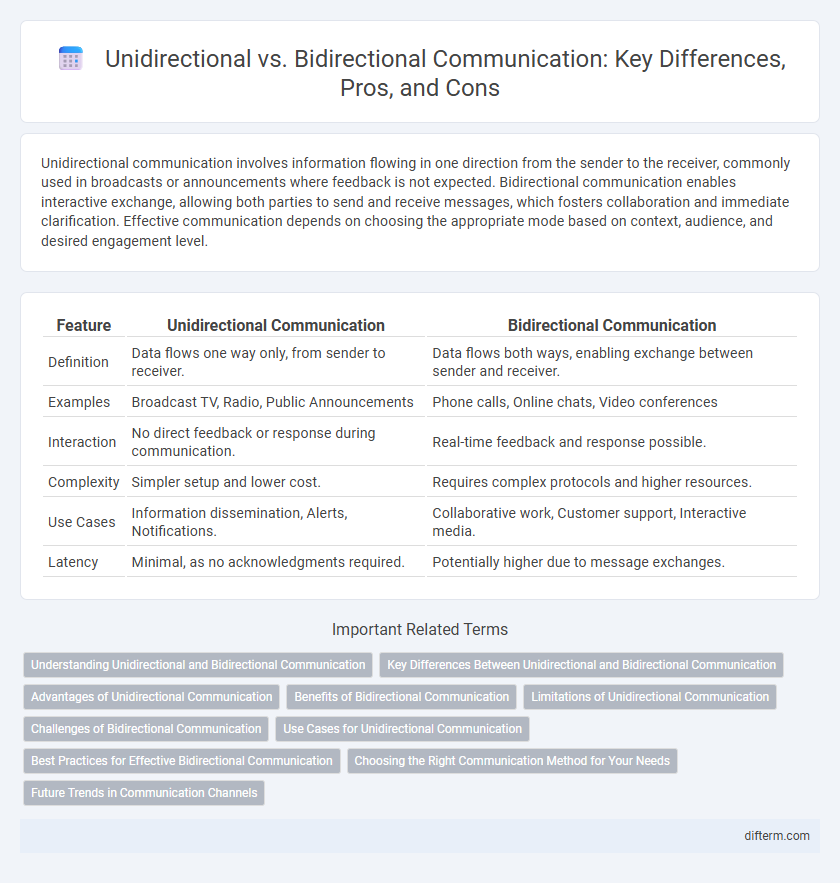Unidirectional communication involves information flowing in one direction from the sender to the receiver, commonly used in broadcasts or announcements where feedback is not expected. Bidirectional communication enables interactive exchange, allowing both parties to send and receive messages, which fosters collaboration and immediate clarification. Effective communication depends on choosing the appropriate mode based on context, audience, and desired engagement level.
Table of Comparison
| Feature | Unidirectional Communication | Bidirectional Communication |
|---|---|---|
| Definition | Data flows one way only, from sender to receiver. | Data flows both ways, enabling exchange between sender and receiver. |
| Examples | Broadcast TV, Radio, Public Announcements | Phone calls, Online chats, Video conferences |
| Interaction | No direct feedback or response during communication. | Real-time feedback and response possible. |
| Complexity | Simpler setup and lower cost. | Requires complex protocols and higher resources. |
| Use Cases | Information dissemination, Alerts, Notifications. | Collaborative work, Customer support, Interactive media. |
| Latency | Minimal, as no acknowledgments required. | Potentially higher due to message exchanges. |
Understanding Unidirectional and Bidirectional Communication
Unidirectional communication involves information flow from a sender to a receiver without immediate feedback, prevalent in broadcasts and announcements. Bidirectional communication enables interactive exchanges, allowing both parties to send and receive messages, enhancing clarity and collaboration. Understanding these communication modes is crucial for selecting appropriate strategies in organizational and technological contexts.
Key Differences Between Unidirectional and Bidirectional Communication
Unidirectional communication transmits information in a single direction without feedback, commonly seen in broadcasts and public announcements, enabling clear, controlled messaging. Bidirectional communication involves two-way exchanges, allowing feedback and interactive dialogue essential for collaboration and effective problem-solving. Key differences include the flow of information, interaction levels, and feedback presence, impacting responsiveness and engagement in communication processes.
Advantages of Unidirectional Communication
Unidirectional communication ensures clear, consistent message delivery by eliminating the risk of misinterpretation or conflicting responses common in bidirectional interactions. It supports efficient information dissemination in scenarios requiring authoritative control, such as emergency alerts or broadcast announcements. This mode reduces cognitive load on recipients by providing straightforward instructions without the need for immediate feedback or clarification.
Benefits of Bidirectional Communication
Bidirectional communication enhances collaboration by enabling real-time feedback and clarification, reducing misunderstandings. It fosters stronger relationships through active engagement and mutual exchange of information. This dynamic flow of dialogue improves decision-making and responsiveness in various organizational and interpersonal contexts.
Limitations of Unidirectional Communication
Unidirectional communication limits interaction by only allowing messages to flow from sender to receiver without feedback, reducing opportunities for clarification or engagement. This one-way flow can lead to misunderstandings, decreased responsiveness, and ineffective information exchange. Organizations relying solely on unidirectional communication may struggle with employee disengagement and lack of collaborative problem-solving.
Challenges of Bidirectional Communication
Challenges of bidirectional communication include managing message synchronization and ensuring accurate feedback between sender and receiver. Latency issues and potential information overload can disrupt the flow, causing misunderstandings and decreased efficiency. Effective protocols and error-handling mechanisms are crucial to maintain clarity and coherence in interactive exchanges.
Use Cases for Unidirectional Communication
Unidirectional communication is ideal for broadcast scenarios where information flows from a single source to multiple recipients, such as in public announcements, emergency alerts, and live streaming events. It suits situations requiring minimal feedback, ensuring clear and consistent message delivery without interruptions. This communication model enhances efficiency in delivering critical data to large audiences quickly and reliably.
Best Practices for Effective Bidirectional Communication
Effective bidirectional communication thrives on active listening and clear feedback loops, fostering mutual understanding and collaboration. Implementing structured check-ins and utilizing digital tools enhances real-time interaction and accountability. Prioritizing openness and empathy minimizes misinterpretations and strengthens relationships within teams or between stakeholders.
Choosing the Right Communication Method for Your Needs
Selecting the appropriate communication method depends on the context and objectives; unidirectional communication efficiently delivers clear, consistent messages to large audiences without immediate feedback, ideal for announcements and broadcasting. Bidirectional communication fosters interaction and engagement, enabling real-time feedback and collaboration, which benefits team discussions, customer service, and relationship-building. Analyze factors such as message complexity, urgency, audience size, and desired response to determine whether a one-way or interactive communication approach best serves your needs.
Future Trends in Communication Channels
Future trends in communication channels emphasize the growing dominance of bidirectional communication over traditional unidirectional methods, driven by advancements in AI-powered chatbots, real-time collaboration tools, and interactive social media platforms. Enhanced user engagement and personalized experiences are enabled by two-way feedback loops and adaptive communication technologies. Emerging 5G networks and augmented reality (AR) interfaces further facilitate seamless, immersive bidirectional interactions across diverse sectors.
unidirectional vs bidirectional Infographic

 difterm.com
difterm.com